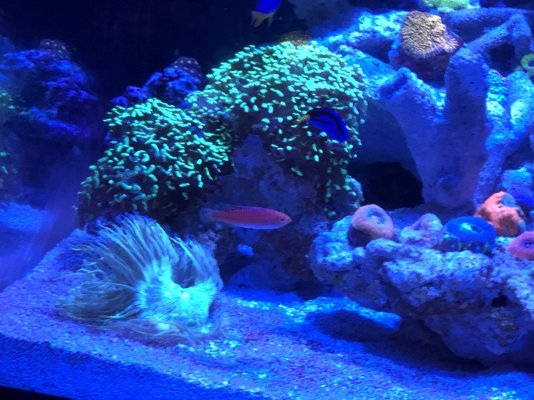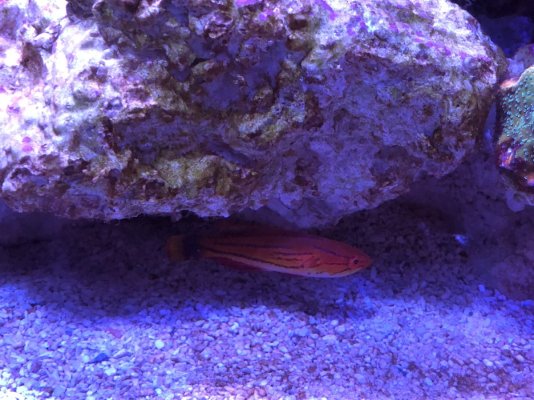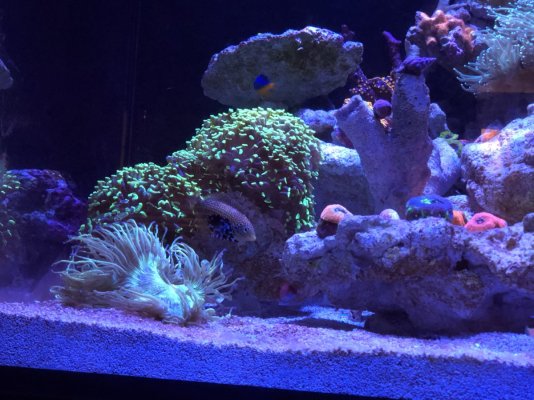Navigation
Install the app
How to install the app on iOS
Follow along with the video below to see how to install our site as a web app on your home screen.
Note: This feature may not be available in some browsers.
More options
You are using an out of date browser. It may not display this or other websites correctly.
You should upgrade or use an alternative browser.
You should upgrade or use an alternative browser.
The Wrasse Lover's Thread!
- Thread starter Breakin Newz
- Start date
- Tagged users AtulR
i cant think
Wrasse Addict
View Badges
Excellence Award
Reef Tank 365
Article Contributor
UK Reef Club Member
Rock Pool Reef Keepers
My Tank Thread
My Aquarium Showcase
The earlei and mutant fairies are stunning. Your earlei looks nice and fateventually they’ll be out and about, once they settle.
exploring every inch of your tank!

(get a lid if you don’t have one already…)
The earlei and mutant fairies are stunning. Your earlei looks nice and fat
thank you good sir!
Was Able to Get some Pics, This was supposed to have been terminal Phase male Splendid, So I will be addressing with LA in the AM, Bought from DD, not what I paid for. My Carpenter under rock, and finally got a nice shot of my Blue Star....
Attachments
Recently added the Feminine Tamarin Wrasse (Anampses femininus)

to my following collection:
- China Tamarin Wrasse (Anampses neoguinaicus)
- Radiant Wrasse (Halichoeres iridis)
- Melanurus Wrasse (Halichoeres melanurus)
- Solar Fairy Wrasse (Cirrhilabrus solorensis)
- Ruby Head Fairy Wrasse (Cirrhilabrus cf cyanopleura)
- Mystery Wrasse (Pseudocheilinus ocellatus)
- Bluestreak Cleaner Wrasse (Labroides dimidiatus)



Every month or so, I will continue to do so, especially the Anampses and Halichoeres family.
to my following collection:
- China Tamarin Wrasse (Anampses neoguinaicus)
- Radiant Wrasse (Halichoeres iridis)
- Melanurus Wrasse (Halichoeres melanurus)
- Solar Fairy Wrasse (Cirrhilabrus solorensis)
- Ruby Head Fairy Wrasse (Cirrhilabrus cf cyanopleura)
- Mystery Wrasse (Pseudocheilinus ocellatus)
- Bluestreak Cleaner Wrasse (Labroides dimidiatus)
Every month or so, I will continue to do so, especially the Anampses and Halichoeres family.
Last edited:
i cant think
Wrasse Addict
View Badges
Excellence Award
Reef Tank 365
Article Contributor
UK Reef Club Member
Rock Pool Reef Keepers
My Tank Thread
My Aquarium Showcase
With the Cirrhilabrus cf cyanopleura, do you mean what is now known as Cirrhilabrus chalasai?Recently added the Feminine Tamarin Wrasse (Anampses femininus)

to my following collection:
- China Tamarin Wrasse (Anampses neoguinaicus)
- Radiant Wrasse (Halichoeres iridis)
- Melanurus Wrasse (Halichoeres melanurus)
- Solar Fairy Wrasse (Cirrhilabrus solorensis)
- Ruby Head Fairy Wrasse (Cirrhilabrus cf cyanopleura)
- Mystery Wrasse (Pseudocheilinus ocellatus) 150
- Bluestreak Cleaner Wrasse (Labroides dimidiatus)



Every month or so, I will continue to do so, especially the Anampses and Halichoeres family.
Also, beautiful tamarin, hopefully you can manage to keep her longterm and not suffer any issues
You did in fact get a Cirrhilabrus isosceles however instead of a terminal phase it appears you got a transitional phase male.Was Able to Get some Pics, This was supposed to have been terminal Phase male Splendid, So I will be addressing with LA in the AM, Bought from DD, not what I paid for. My Carpenter under rock, and finally got a nice shot of my Blue Star....
As for the Carpenters, it looks like you instead got a mccoskeri however if you can try to get a photo of an extended dorsal fin then it would be much easier to ID.
I had to euthanize my McCosker wrasse last night.
He wasn't getting any better and had stopped eating.
Could no longer right himself and would just lay on the bottom of the tank belly up.
bummer.
He wasn't getting any better and had stopped eating.
Could no longer right himself and would just lay on the bottom of the tank belly up.
bummer.
Thanks for the heads up on Ruby Head Fairy Wrasse, see attached “not my photo”. Do you reckon it belongs to Cirrhilabrus chalasai.With the Cirrhilabrus cf cyanopleura, do you mean what is now known as Cirrhilabrus chalasai?
Also, beautiful tamarin, hopefully you can manage to keep her longterm and not suffer any issues
You did in fact get a Cirrhilabrus isosceles however instead of a terminal phase it appears you got a transitional phase male.
As for the Carpenters, it looks like you instead got a mccoskeri however if you can try to get a photo of an extended dorsal fin then it would be much easier to ID.
BTW, what else should I be looking for keeping the feminus tamarin? I got it from a fellow that had her for close to a year. It’s eating very well and not hiding, even brave enough to steal from the carpet anemone (that’s my biggest fear for her life at the moment). I’m feeding Dr G medicated Dewormer food (Praziquantel) periodically. All my wrasses ate like pigs, without the slightest aggression to each other. But I gotta admit, I feed heavy, very heavy.
Thanks will try get a better shot of the Carpenters/Mccosker. Thanks for the correctionWith the Cirrhilabrus cf cyanopleura, do you mean what is now known as Cirrhilabrus chalasai?
Also, beautiful tamarin, hopefully you can manage to keep her longterm and not suffer any issues
You did in fact get a Cirrhilabrus isosceles however instead of a terminal phase it appears you got a transitional phase male.
As for the Carpenters, it looks like you instead got a mccoskeri however if you can try to get a photo of an extended dorsal fin then it would be much easier to ID.
i cant think
Wrasse Addict
View Badges
Excellence Award
Reef Tank 365
Article Contributor
UK Reef Club Member
Rock Pool Reef Keepers
My Tank Thread
My Aquarium Showcase
That photo you’ve shown does appear to be what recently got changed from being known as C. solorensis to C. chalasai. It’s like Cirrhilabrus finifenmaa recently being separated from Cirrhilabrus rubrisquamisThanks for the heads up on Ruby Head Fairy Wrasse, see attached “not my photo”. Do you reckon it belongs to Cirrhilabrus chalasai.

BTW, what else should I be looking for keeping the feminus tamarin? I got it from a fellow that had her for close to a year. It’s eating very well and not hiding, even brave enough to steal from the carpet anemone (that’s my biggest fear for her life at the moment). I’m feeding Dr G medicated Dewormer food (Praziquantel) periodically. All my wrasses ate like pigs, without the slightest aggression to each other. But I gotta admit, I feed heavy, very heavy.
With the femininus, you will need to keep watching for any signs of an issue, even internal parasites. If she continues to eat but starts getting thin then that’s a huge sign of disease. She doesn’t seem to show any pinching going on but it’s rather hard to see with the photo (Obviously, wrasses hate photos and prefer to swim away at high speeds). In the photo you got she looks nice and healthy which is always the best way to start with a wrasse as sensitive as Anampses femininus or Macropharyngodon choati. I personally don’t recommend QTing the fish (Even if it wasn’t QTed already) as it often just kills and does more harm than good.
i cant think
Wrasse Addict
View Badges
Excellence Award
Reef Tank 365
Article Contributor
UK Reef Club Member
Rock Pool Reef Keepers
My Tank Thread
My Aquarium Showcase
No worries!Thanks will try get a better shot of the Carpenters/Mccosker. Thanks for the correction
If you’ve got a mccoskeri then on it’s dorsal fin he will only have one filament whereas a Carpenteri would have several. The reason I suspect Mccoskeri is due to how much black is on the fins, Carpenters don’t have a ton of black however the black fin mccoskers have a ton of black that is very obvious.
Yes, I’ve learnt NOT to QT wrasses early into the hobby; very high mortality rate, sometimes death within the first 3 hour of QT even from seemingly healthy fishes at the LFS. Since then I’ve been feeding heavy with Mysis soaked in Dr G’s medicated food (DEWORMER or ANTI BACTERIAL), as long as they eat, I have been 100% successful.That photo you’ve shown does appear to be what recently got changed from being known as C. solorensis to C. chalasai. It’s like Cirrhilabrus finifenmaa recently being separated from Cirrhilabrus rubrisquamis
With the femininus, you will need to keep watching for any signs of an issue, even internal parasites. If she continues to eat but starts getting thin then that’s a huge sign of disease. She doesn’t seem to show any pinching going on but it’s rather hard to see with the photo (Obviously, wrasses hate photos and prefer to swim away at high speeds). In the photo you got she looks nice and healthy which is always the best way to start with a wrasse as sensitive as Anampses femininus or Macropharyngodon choati. I personally don’t recommend QTing the fish (Even if it wasn’t QTed already) as it often just kills and does more harm than good.
Last edited:
Awesome thank for all the information on that, when I saw a store it had a black tail did notice much black on other fins until I saw photo.No worries!
If you’ve got a mccoskeri then on it’s dorsal fin he will only have one filament whereas a Carpenteri would have several. The reason I suspect Mccoskeri is due to how much black is on the fins, Carpenters don’t have a ton of black however the black fin mccoskers have a ton of black that is very obvious.
Alright ladies and gents... I lost a few wrasses with the temp rehome, planning to dunk water back in the 120g by Thursday and I'm wondering what should I pursue with my current combo...
Christmas Wrass
Lubbock's wrass
Melanurus wrasse
Coris wrasse
I'm planning a replacement pencil wrasse for sure, in the 120g. Any other suggestions? May leave the melanurus & coris wrasse in the 50g along with a pair of skunk clowns.
TIA.
Christmas Wrass
Lubbock's wrass
Melanurus wrasse
Coris wrasse
I'm planning a replacement pencil wrasse for sure, in the 120g. Any other suggestions? May leave the melanurus & coris wrasse in the 50g along with a pair of skunk clowns.
TIA.
i cant think
Wrasse Addict
View Badges
Excellence Award
Reef Tank 365
Article Contributor
UK Reef Club Member
Rock Pool Reef Keepers
My Tank Thread
My Aquarium Showcase
I wouldn’t leave the coris in the 50g as they are nasty once they age. Other suggestions for wrasses;Alright ladies and gents... I lost a few wrasses with the temp rehome, planning to dunk water back in the 120g by Thursday and I'm wondering what should I pursue with my current combo...
Christmas Wrass
Lubbock's wrass
Melanurus wrasse
Coris wrasse
I'm planning a replacement pencil wrasse for sure, in the 120g. Any other suggestions? May leave the melanurus & coris wrasse in the 50g along with a pair of skunk clowns.
TIA.
Halichoeres iridis & Cirrhilabrus naokoae
Paracheilinus attenuatus and/or cyaneus
Pseudojuloides severnsi pair
Macropharyngodon bipartitus and/or negrosensis
If you can find one, Cirrhilabrus earlei
i cant think
Wrasse Addict
View Badges
Excellence Award
Reef Tank 365
Article Contributor
UK Reef Club Member
Rock Pool Reef Keepers
My Tank Thread
My Aquarium Showcase
Some updates on the wrasses! From my worst photos to my best photos.




i cant think
Wrasse Addict
View Badges
Excellence Award
Reef Tank 365
Article Contributor
UK Reef Club Member
Rock Pool Reef Keepers
My Tank Thread
My Aquarium Showcase
Let’s get some more flashers in here!
These are a few nicer photos of my hybrid (Still unknown what he is a hybrid of). So far what I have found is:
- He has 2-3 filaments - it’s hard to count them as he only really shows them when displaying and he very rarely displays, often he starts to display after the naoko starts his display which isn’t too often.
- He has a very deep purple/red “box” on his dorsal fin, it starts about 2 thirds up the dorsal. This also has a rather faint blue line all the way along where the dorsal meets the main body.
- His anal fin is a rather deep yellow colouration, with a line of electric blue spots somewhere along the dorsal fin just above the blue outline. The blue outline I’m on about is very similar if not the same to the outline seen on my C. lubbocki in the above photo. The shape of his anal fin and pelvic fins (along with some of the pattern on the anal fin) match that of Paracheilinus bellae.
- When he displays he shows a stunningly blue dorsal, it looks completely blue and shows no other colours. As for the other colours that he goes when in full display it’s hard to see as with heavy blues they wash out most colours except the blue.





Combinations that have been assumed so far (in order of what is assumed more likely);
- Paracheilinus filamentosus x Paracheilinus flavianalis
- Paracheilinus filamentosus x Paracheilinus rubricaudalis
- Paracheilinus filamentosus x Paracheilinus flavianalis x Paracheilinus lineopunctatus
- Paracheilinus filamentosus x Paracheilinus rubricaudalis x Paracheilinus lineopunctatus
The bottom two being the newest added, I have also thought about it being a potential Paracheilinus cyaneus hybrid but I’m open to other suggestions of what this specimen could be
These are a few nicer photos of my hybrid (Still unknown what he is a hybrid of). So far what I have found is:
- He has 2-3 filaments - it’s hard to count them as he only really shows them when displaying and he very rarely displays, often he starts to display after the naoko starts his display which isn’t too often.
- He has a very deep purple/red “box” on his dorsal fin, it starts about 2 thirds up the dorsal. This also has a rather faint blue line all the way along where the dorsal meets the main body.
- His anal fin is a rather deep yellow colouration, with a line of electric blue spots somewhere along the dorsal fin just above the blue outline. The blue outline I’m on about is very similar if not the same to the outline seen on my C. lubbocki in the above photo. The shape of his anal fin and pelvic fins (along with some of the pattern on the anal fin) match that of Paracheilinus bellae.
- When he displays he shows a stunningly blue dorsal, it looks completely blue and shows no other colours. As for the other colours that he goes when in full display it’s hard to see as with heavy blues they wash out most colours except the blue.
Combinations that have been assumed so far (in order of what is assumed more likely);
- Paracheilinus filamentosus x Paracheilinus flavianalis
- Paracheilinus filamentosus x Paracheilinus rubricaudalis
- Paracheilinus filamentosus x Paracheilinus flavianalis x Paracheilinus lineopunctatus
- Paracheilinus filamentosus x Paracheilinus rubricaudalis x Paracheilinus lineopunctatus
The bottom two being the newest added, I have also thought about it being a potential Paracheilinus cyaneus hybrid but I’m open to other suggestions of what this specimen could be
Last edited:
SaltyT
Wrasse obsessed!
View Badges
Reef Squad
Excellence Award
Reef Tank 365
Photo of the Month
Article Contributor
Hospitality Award
Midwest Reefer
My Aquarium Showcase
Nice pics of your flasher! I don't have any new pics of my flasher just a recent one.Let’s get some more flashers in here!
These are a few nicer photos of my hybrid (Still unknown what he is a hybrid of). So far what I have found is:
- He has 2-3 filaments - it’s hard to count them as he only really shows them when displaying and he very rarely displays, often he starts to display after the naoko starts his display which isn’t too often.
- He has a very deep purple/red “box” on his dorsal fin, it starts about 2 thirds up the dorsal. This also has a rather faint blue line all the way along where the dorsal meets the main body.
- His anal fin is a rather deep yellow colouration, with a line of electric blue spots somewhere along the dorsal fin just above the blue outline. The blue outline I’m on about is very similar if not the same to the outline seen on my C. lubbocki in the above photo. The shape of his anal fin and pelvic fins (along with some of the pattern on the anal fin) match that of Paracheilinus bellae.
- When he displays he shows a stunningly blue dorsal, it looks completely blue and shows no other colours. As for the other colours that he goes when in full display it’s hard to see as with heavy blues they wash out most colours except the blue.





Combinations that have been assumed so far (in order of what is assumed more likely);
- Paracheilinus filamentosus x Paracheilinus flavianalis
- Paracheilinus filamentosus x Paracheilinus rubricaudalis
- Paracheilinus filamentosus x Paracheilinus flavianalis x Paracheilinus lineopunctatus
- Paracheilinus filamentosus x Paracheilinus rubricaudalis x Paracheilinus lineopunctatus
The bottom two being the newest added, I have also thought about it being a potential Paracheilinus cyaneus hybrid but I’m open to other suggestions of what this specimen could be
Similar threads
- Replies
- 116
- Views
- 2,467
- Replies
- 8
- Views
- 823
- Replies
- 11
- Views
- 231



















